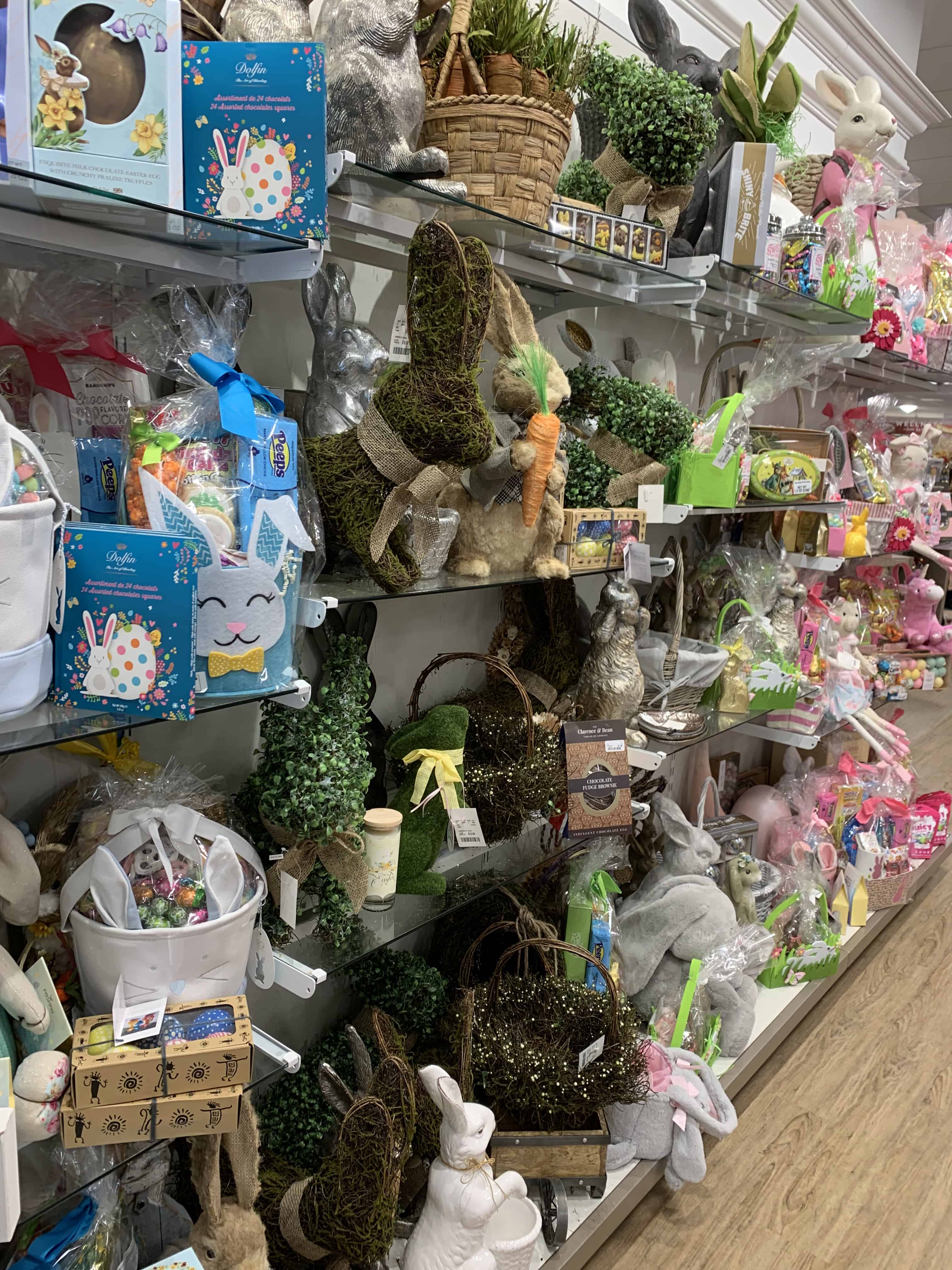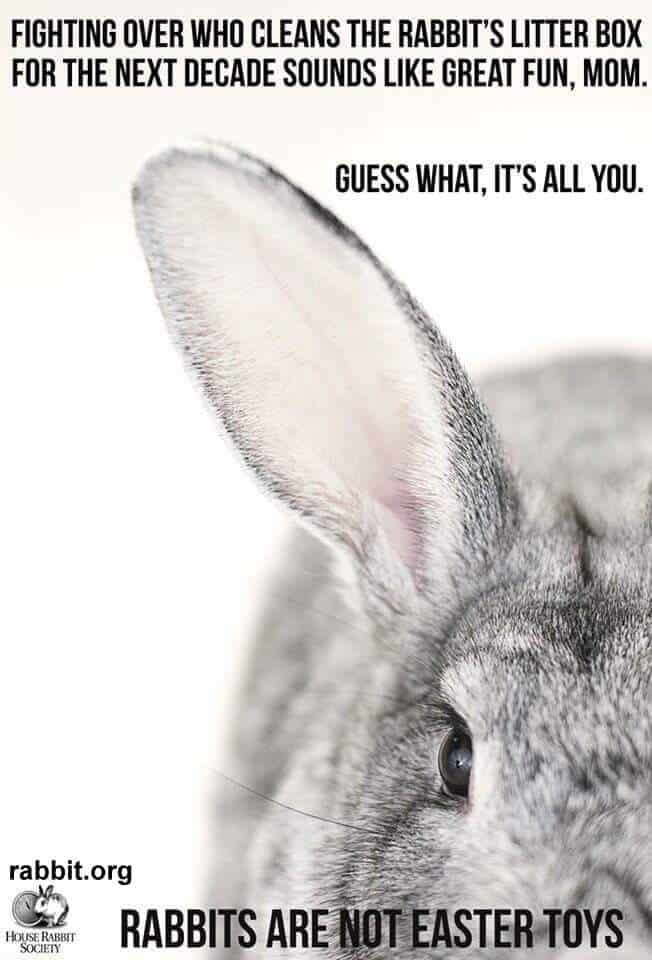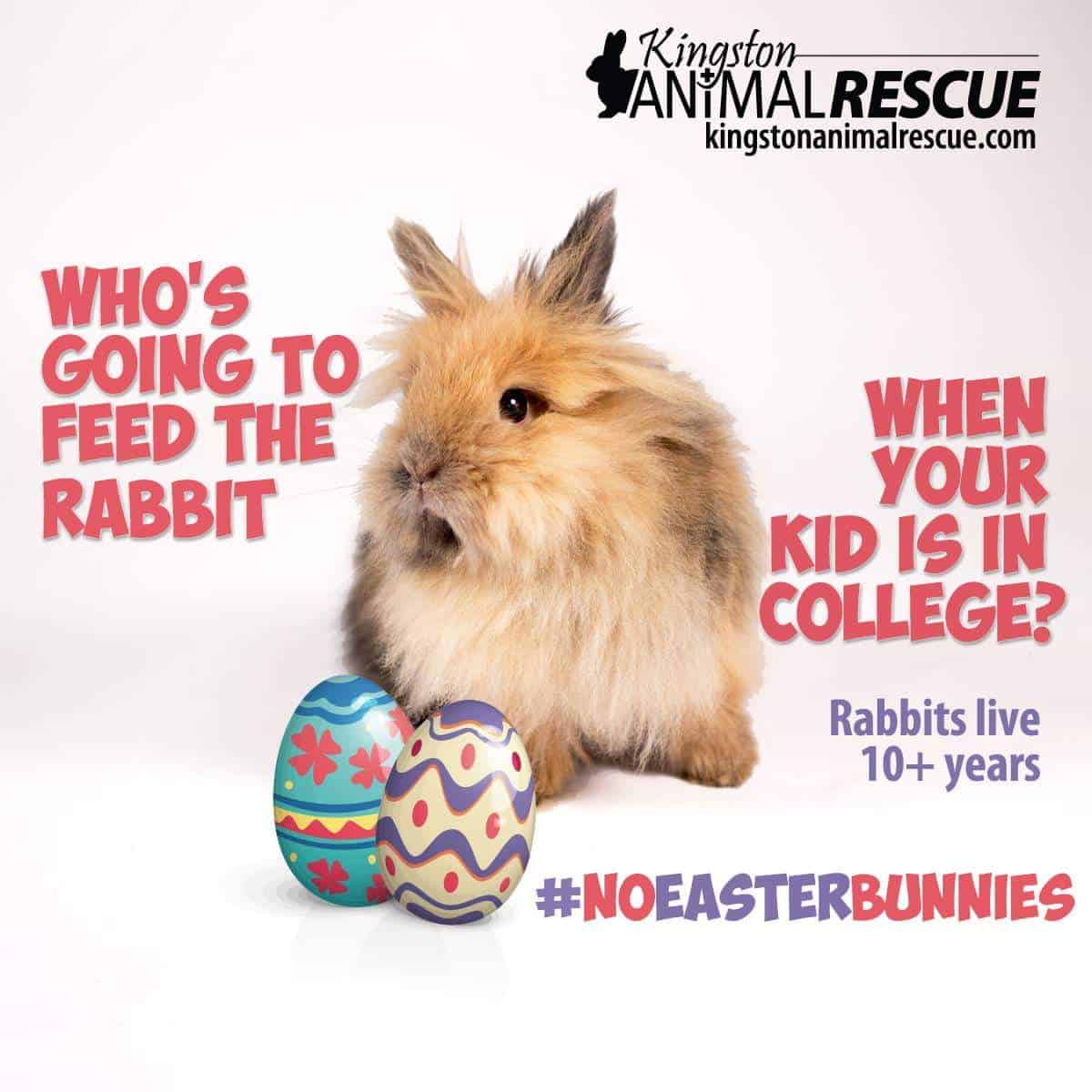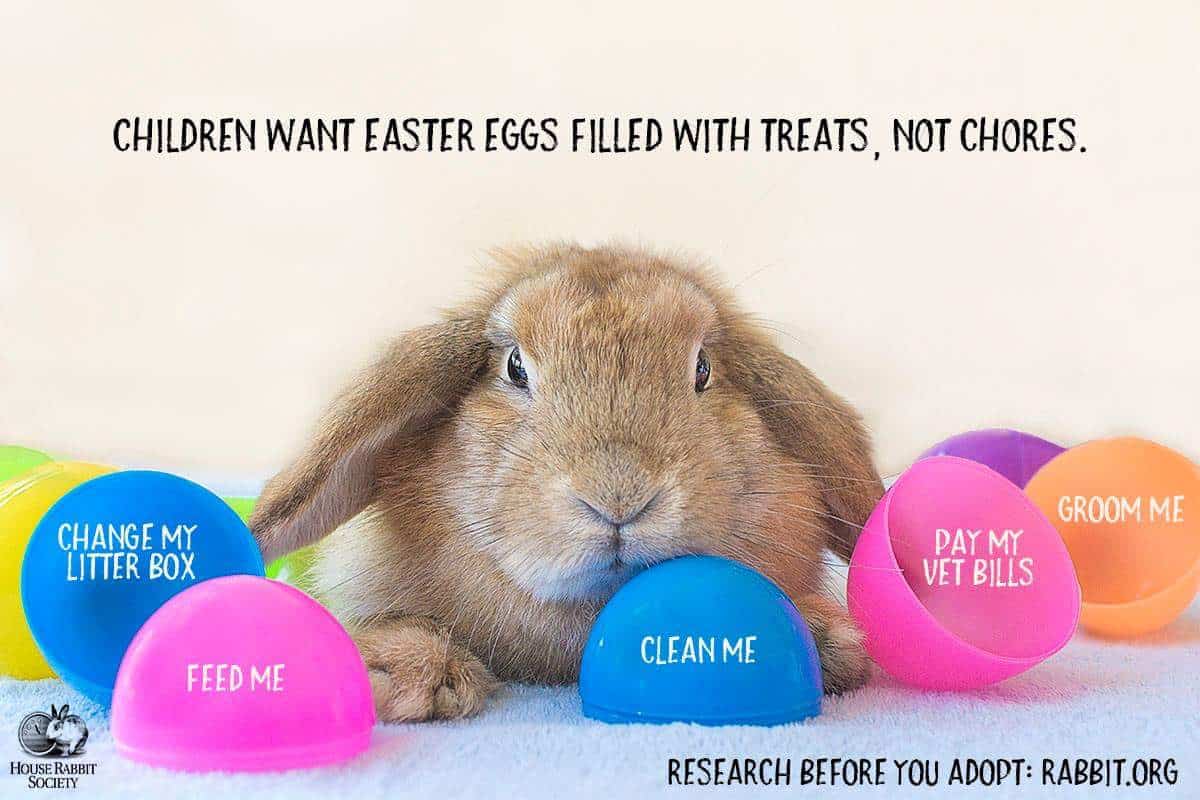One Campaign, Two Audiences: Marketing to Conflicting Personas
When it comes to digital marketing, creating purposeful, personalized and persuasive messages to your target audience is critical. But what do you do if you need to target two distinct personas in one piece while influencing them to take opposite courses of action? That’s the challenge rabbit advocates face this time every single year, and it’s something we can all learn from.
Meet Katie Beatrice Smith (aka Katie B, aka Katie Bun, aka Bunny Bunches of Oats).
Katie is a mini lop rabbit and my living alarm clock — if I’m not up by 7:00 a.m., I feel 5 pounds and 6 ounces of bunny hop on me. She loves eating hay, binge watching TV and devouring pieces of banana (though she’s on a strict one-bite-per-month diet).
View this post on Instagram
What she doesn’t love? All the irresponsible purchases of her fellow lagomorphs around Easter.
Easter Is a Bad Time for Bunnies
 Starting in March, you can’t go anywhere without seeing bunny toys, bunny-shaped chocolates and bunny-centric advertisements. Let’s face it, bunnies are stinking cute!
Starting in March, you can’t go anywhere without seeing bunny toys, bunny-shaped chocolates and bunny-centric advertisements. Let’s face it, bunnies are stinking cute!
It’s no wonder children beg for the real living animals and, given the misinformation regarding their care, cost and lifespan, parents often comply.
Months later, the once docile baby rabbit becomes an aggressive, unfixed, chewing machine that the kids don’t go near — and off to the shelter the bun goes. Shelters and rescues are overrun with unwanted rabbits for months after the Easter holiday.
Rab-vocates (my own word for rabbit advocates) are faced with this challenge every year: how do we dissuade the wrong people from adopting rabbits on an uneducated whim, while not alienating the right people from rescuing them at our time of greatest need?
Bunny protectors have used all forms of digital media to get the message out to parents and children — so let’s take a look at some of our favorite examples. But first, let’s talk about the strategies that makes them shine.
Understanding the Target Audiences
The backbone of all good strategies is understanding the target audience. In this case, we’re looking at two distinct personas. The first is the person we’re trying to dissuade: the parent who may make a rabbit purchase on a whim. We’ll call her Susan. The second is the person we want to persuade: the responsible pet owner who needs to see the magic of rabbits while the shelters are overrun with abandoned Easter bunnies. We’ll call her Mary. Let’s take a closer look at who they are and the path they might take to purchase. en iyi bahis siteleri
RELATED: Customer Profiles, Personas and Buyer’s Journeys: What to Know and How to Build Them
Susan’s Persona (Lite) and Buyer’s Journey
Susan is a thoughtful friend, a kind neighbor and a wonderful, doting mother of two young boys. As a girl, her family had a pet rabbit in a hutch outside who died of fright in his first year when a predator attempted to rip open the cage. Despite his brief and tragic life, Susan remembers Bugs as adorable and low maintenance.

You can see the opportunities to influence this persona on her journey are limited to mass-market, multi-media awareness campaigns that attempt to dissuade before the awareness stage; paid search and PPC retargeting for pet store searches during consideration; and in-store education and/or refusal to sell at the hope-she-doesn’t-purchase stage.
Alternatively, with educational content, a Susan lookalike may turn into a great owner, but, for our purposes, let’s focus on the Susan who won’t change.
Mary’s Persona (Lite) and Buyer’s Journey
Mary is a single city-dweller. She’s finally reached financial stability and is living on her own. While she would love some companionship, she doesn’t have the space for a dog to run around and most cats are too independent for her liking. She’s had fish and hamsters, but their short lifespans and cages/tanks aren’t ideal for Mary, who wants to have a real connection with another being. She has resigned herself to believing she must wait until she’s in a larger home, since she thinks the only option is a dog.
But wait — what’s that she sees? A cute, fluffy animal with big, friendly personality that’s comfortable in a compact space like her apartment?

If you can’t read this tiny font, you can at least see that Mary’s journey is much more complex and involves ample research. But prior to seeing a post about rabbits and Easter, the cute little hopping bunnies aren’t even on Mary’s radar. These Easter communications have to trigger her research by addressing her needs — a long-term, friendly, indoor companion that doesn’t need as much space as a dog.
Uncovering the Right Messages
Understanding their journeys now and that our goal is to dissuade Susan prior to entering Consideration and to trigger Mary’s Consideration stage, we can see we need to rely on broad, mass-market tactics that speak to them both. Therefore, the most effective messaging will highlight aspects of rabbit ownership that Susan will see as a negative, but Mary will see as a positive.
To find those points of intersection, let’s explore some of the top “reasons to believe” about rabbit ownership and how each persona will perceive that message — green indicates persuasive messages, yellow indicates proceed with caution and red means danger.
| REASONS TO BELIEVE | SUSAN’S PERCEPTION | MARY’S PERCEPTION |
| Life-span: Rabbits live an average of 10 years. |
Susan’s willing to make the rabbit purchase because she thinks rabbits only live two years. When she finds out it’s closer to 10, that could be enough to dissuade her, but one more point will put her over the edge. | Mary also believes rabbits have a two-year lifespan. To learn of their longevity will put them on her consideration list, but that alone isn’t enough because she wants to be able to interact readily with her pet and still believes they live in cages. |
| Commitment: Rabbits are not low-maintenance. They do best with large pens or no cage; require nearly constant attention as social creatures; need to be fed multiple times a day with constant access to hay and water; need their litter box cleaned daily; and they need to be groomed weekly. | Susan likely already knows the responsibility for this rabbit is going to fall on her (though reminding her will serve our purposes well). What she doesn’t know is how much work actually goes into caring for a rabbit. If we can show her that, she’s going to think twice. | Adding the fact that rabbits can live cage-free will sell her on doing the research. And, true Marys won’t be scared away by mentions of the work that goes into rabbit care, as long as it’s not oversold. She’ll uncover all of this in her research regardless. |
| Cost: Rabbits require specialized vets and are susceptible to expensive diseases. | As common as rabbits are, it would not occur to Susan that they need special medical care. | Overselling the costs could deter Mary from digging in further. While she needs to understand the costs before committing, getting her to see the value of a rabbit before the costs is critical. |
| Destructive: Rabbits have a tendency to chew and shred. Baseboards, W-2s, cardboard boxes, rugs and especially accessible cords are all susceptible to the bun-struction. | Susan will not want her house destroyed, so while this may dissuade her from the rabbit purchase altogether, it may just convince her to keep the rabbit in a cage, which is not an acceptable solution for many rab-vocates. | Mary will learn about bun-struction in her research while she simultaneously learns about the solution: bunny proofing. To focus deterring Susan with rabbits’ destructive nature without talk of bunny proofing may also inadvertently dissuade Mary this early in her buying journey. |
| High-Abandon Rate: Most bunnies purchased as Easter gifts are abandoned within months of the holiday. | Susan doesn’t care that rabbits are abandoned — she doesn’t think that fact alone means she’s going to abandon one. We must be careful about making this a primary message. | Knowing there’s a high need can help drive more urgency for Mary to act. |
Given this assessment, the most effective communications will highlight both life-span and commitment, while optionally mentioning cost as a tertiary factor.
Now Let’s Take a Look at Some of Our Favorite Marketing Campaigns
With this messaging strategy in mind, we evaluated digital marketing geared toward keeping rabbits out of bad homes and getting them into good ones at Easter time and made our top picks. Our sample set certainly wasn’t exhaustive, but here’s what caught our attention.
Video
Videos grant opportunities for ample information, so they’re able to cover all the reasons to believe. This hits on all the important facts while using humor. Warning: it uses a little bit of explicit language.
Long-Form
Like with video, long-form allows rab-ocates to speak to many reasons to believe. This Imgur post hits all the points well — and in the voice of a bunny.
Social Media
Keeping things short is a challenge. Our top three chosen social media posts don’t address “commitment” in the way that would be best to message Mary, but they do check the boxes on our priority messages with a dash of humor and a whole lot of cute.



Learn More About Rabbits
Learn more about rab-vocates’ work to combat the Easter problem on Make Mine Chocolate. If you’d like to learn more about rabbit care, check out the House Rabbit Society. And, if you’re interested in getting a rabbit of your own, remember to adopt, don’t shop!
Making This Methodology Work for You
Effective digital marketing is all about understanding who your target audience is and what message will resonate with them the most. Points of intersection allow us to strategically scale, while unique moments in a persona’s buyer’s journey allow us to get truly personalized.
You likely don’t have a marketing goal focused on finding good homes for bunnies. But you do have a business with unique customers who go on journeys we can understand and market to. If you want to learn more about how to drive your business forward with customer-centric marketing, let’s talk.


